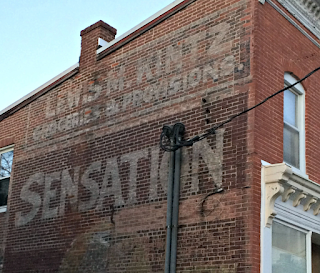She Recognized the Old Lady in the Coffin
Too many family histories read, to the outsider, like a litany of birth dates, marriage dates, death dates, the dates of everyone’s descendants and everyone’s ancestors and everyone’s cousins, all the small-print data that my mother, no genealogist, dismissed as “the begats” – “like the parts of the Old Testament you skip.” My mother wanted stories.
She would have enjoyed Florence Harris Abel’s 1986 book The Beitzel Family, an unexpected treasure in the stacks at Frostburg State University’s Ort Library. Yes, Abel includes all the begats of her sprawling Garrett County subject, but like Deuteronomy they are easily skipped to get to the wealth of good stories. Abel even includes stories on a theme most family histories shun: the supernatural.
Abel titles one “The Midnight Visitor.” One night in spring 1930, not long after their marriage, while Beitzel descendant Clarence Sell peacefully slept, young Mrs. Sell* beside him was abruptly awakened.
Looking up she saw a strange elderly woman leaning over the bed, gazing intently at Clarence. Startled, she tried to awaken Clarence, but when he opened his eyes, the old woman was gone.
Abel doesn’t describe the ensuing conversation, but one easily can imagine Clarence reassuring his wife that it was just a bad dream, nothing to worry about. Today, the Clarences of the world might cite the humanoid hallucinations associated with sleep paralysis, a nearly universal, well-researched, sometimes-terrifying phenomenon that the people of Newfoundland traditionally called “the old hag” – hence the vivid, if vaguely misogynistic, phrase “old hag syndrome.”
Later – Abel doesn’t specify how much later, as oral tradition likely elided that part – the Sells attended the funeral, at St. Paul’s Lutheran Church in Accident, of Clarence’s great-aunt, Mary Shoemaker Beitzel, who died April 13, 1930, in nearby Bittinger, age 88. "Granma Mary" loomed large in Clarence’s extended family, but was sufficiently distant (and, perhaps, sufficiently intimidating) that Mrs. Sell had never met her.
It was an open-casket funeral, and when Mrs. Sell spied the woman lying there, she felt a chill and cried: “Look, Clarence! That is the old woman who was leaning over our bed looking at you that night.”
To the members of the Society for Psychical Research, Mrs. Sell’s vision of the presumably dying old lady might be classified as a “crisis apparition”; the rest of us might consider it an “omen” or “sign.” In the Beitzel family, as Abel explains it, the same sort of portent traditionally was known as a “token.”
A token was the sign or signal of someone’s death, often occurring with the manifestation of the person’s image or a symbolic occurrence. Just as a ghost is often not recognized as a ghost until it is gone, so a token frequently is not recognized as a token until after the person has died. Some think that as the spirit begins to loosen itself from the earthly body, it enters the presence of persons it has known in this life. … The older generation frequently talked of seeing tokens.
This was far from the only token in the Beitzel family; in fact, it wasn't even the only token of Granma Mary's death, as we will see.
Mary Shoemaker Beitzel is buried in St. Paul's "New" Cemetery in Accident. Her epitaph: "There is rest in heaven."
*If Abel includes Mrs. Sell’s first name, I missed it.
Sources:
Abel, Florence Harris. The Beitzel Family. Baltimore: Gateway P, 1986. Pages 66-67.
"Mary Elizabeth Shoemaker Beitzel." Find a Grave. https://www.findagrave.com/memorial/61887429/mary-elizabeth-beitzel. Accessed 13 Nov. 2021.
Stanborough, Rebecca Joy. “Understanding ‘Old Hag’ Syndrome: What It Means When You’re Paralyzed in Your Sleep.” Healthline 20 July 2020. https://www.healthline.com/health/sleep/old-hag-syndrome. Accessed 12 Nov. 2021.

Comments
Post a Comment